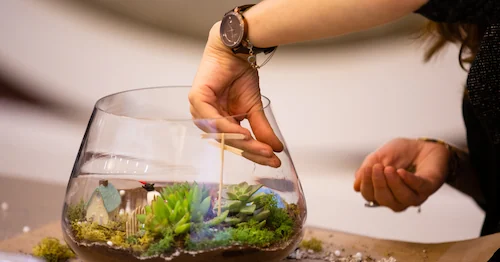Hi! Welcome to FunEmpire 👋
We take pride in finding the best local experiences, activities and services. We only recommend what we love, and hope you love them too. Learn about our story.

Terrariums are the next best alternatives for growing plants in places that are not very conducive; especially for most of us who have low-light work space or moisture-deficient living rooms. Hence, a terrarium becomes a biosphere that elevates humidity, keeps plants self-watered, and regulates the overall mini ecosystem on autopilot with minimal interference.
Not only do terrariums allow you to control the thriving environment, but you can also personalize your terrarium with fun figurines and decorative landscaping to suit your taste.
Without further to do, here are 9 insider tips for creating your very own mini garden.
1. Find a suitable container

Image retrieved from https://www.pinterest.com/pin/701154235707258424/?Ip=true
The first question you would want to ask yourself is; if you want to use a plastic or a glass container to grow your plants in. While glass is relatively cheaper and easily available, a plastic terrarium weighs less and is more durable. However, plastic is more prone to discoloration and scratches; while glass terrariums are limited to only certain shapes and sizes.
You will also need to decide if you want an open or closed terrarium. Open terrariums are ideal for plants that need more sunlight, while closed terrariums are perfect for plants that flourish in high humidity.
In general, the options are neverending; just be daring and don’t be afraid to explore different types of containers!
2. Sand, Charcoal, and Pebbles

Image retrieved from https://www.sunset.com/travel/how-to-make-a-sand-terrarium
In order to prevent your plants from rotting, you will need to a layer of sand and pebbles to aid with the drainage of water.
Afterwards, top it with a thin layer of crushed charcoal to encourage the absorption of excess moisture as well as reduce bacteria and odors.
In an average-sized terrarium, a one-inch layer of sand, charcoal, and pebbles mix is ample when you are just starting out learning how to build a terrarium.
3. The Right Soil
Image retrieved from https://www.teresasplants.com/Terrarium-Soil-Quart-Bag-_p_39.html
Although terrariums do not require that much maintenance, you should always keep in mind to find the right soil for your plants when learning how to build your terrarium. Packaged soil made specifically for terrariums can be found in numerous home and garden stores, although regular potting soil can also be used; just ensure that it is high in organic matter.
We recommend choosing a light, humus-soil potting mix as a planting medium; and adding enough soil to cover the plant roots.
4. Selecting the appropriate plants

Image retrieved from https://www.46spruce.com/blogs/home-garden-blog/closed-terrariums-vs-open-terrariums
With the infinite number of possibilities, it can often become a problem when it boils down to choosing the right plants for your mini garden.
For closed-top terrariums, plants should be compact, be able to tolerate humidity and low-light. Preferable options include ferns, mosses, bromeliads, and orchids.
For open-top terrariums, plants should thrive in bright light and low humidity; such as cactuses, succulents, and most herbs like mints.
Bare in mind that you should always choose slow growing plants in order to prevent overcrowding. Also, do ensure that the selected plants are small enough to fit into your terrarium without touching the sides.
5. Layering

Image retrieved from https://www.46spruce.com/blogs/home-garden-blog/closed-terrariums-vs-open-terrariums
If your terrarium is closed, add a layer of sand and crushed charcoal mixture for drainage. Next, add the pebbles, then pour another layer of sand and charcoal mixture across the pebbles. When done, add the soil and leave holes large enough to allow room for for the roots of your plants.
Once done, observe your terrarium to ensure that the materials are about one-third the height of your container; with the soil layer being the thickest at this point. Pack the soil layer to ensure that all air pockets are gone before adding your plants.
6. Planting your plants
Make sure your plants are firmly rooted when you plant them, and lightly mist your terrarium afterwards.
If you have an open terrarium, your plants should be watered once a week. Bare in mind to avoid any mosses which do not require as much water. The soil should be just barely moist, not wet or bone dry.
If you have a closed terrarium, then you do not really need to water it.
7. The Right Location
Be very careful on where you place your terrarium! Avoid direct sunlight which can fry your plants!
8. Pruning
When it starts to get crowded in the terrarium, carefully prune the plants and remove and dead or wilted leaves to help prevent rotting and keep the eco-system healthy.
9. Fresh Air
Air your terrarium after every 10 days by opening the lid for half a day, then closing it up again. If no condensation appears after closing the lid, try adding a tiny amount of water.
If you wish to get started on building your terrarium but have no idea how to begin and seek professional guidance, then visit https://www.thefunempire.com/terrarium/ for more information.
Happy Terrarium building!







